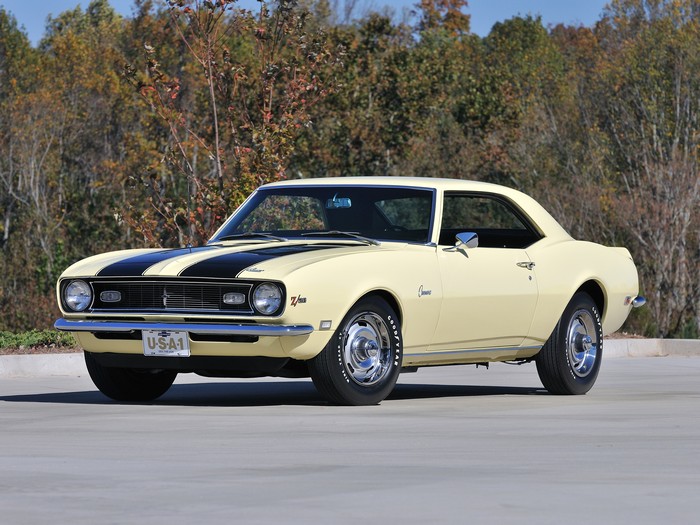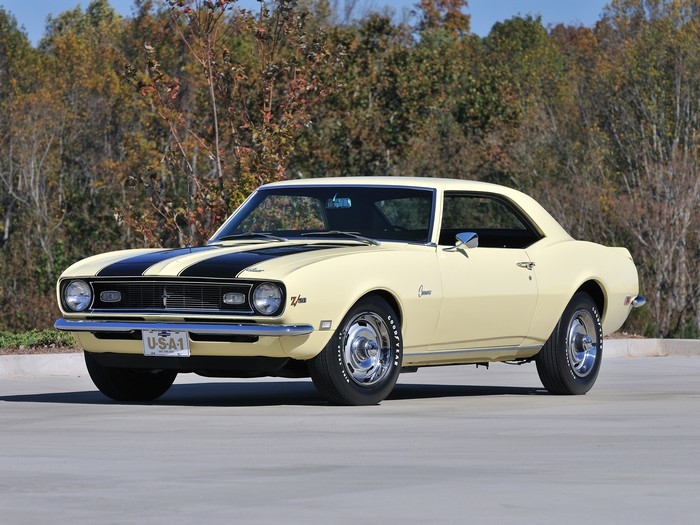
• Purchased from the original owner after being in storage for over 30 years
• No rust and never wrecked
• Original body panels
• Received correct and complete restoration
• All engine, transmission and rear end components are original and correct
• Original window sticker
• Original license plate
• Original Protect-O-Plate
• Owner’s manual
SCM Analysis
Detailing
| Vehicle: | 1968 Chevrolet Camaro Z/28 |
| Years Produced: | 1967–69 |
| Number Produced: | 7,199 (’68 Z/28) |
| Original List Price: | $3,355, base ’68 Z/28 |
| SCM Valuation: | $38,000–$57,500 |
| Tune Up Cost: | $200 |
| Distributor Caps: | $14 |
| Chassis Number Location: | Stamped on plate attached to driver’s side dash, underneath windshield |
| Engine Number Location: | Stamped on passenger’s side front of block, below cylinder head |
| Club Info: | American Camaro Association |
| Website: | www.americancamaro.org |
| Alternatives: | 1968 Ford Mustang Boss 302, 1969 Pontiac Trans Am, 1970 Plymouth AAR ’Cuda |
| Investment Grade: | B |
This 1968 Chevrolet Camaro Z/28, Lot F229, sold for $63,600, including buyer’s premium, at Mecum’s Kissimmee auction in Kissimmee, FL, on January 25, 2013.
There are a lot of important GM muscle cars, but in terms of iconic status, there aren’t many that can touch the first-gen Z/28. Built to take on the Mustang, which was dominating the Trans Am race series in 1966 and 1967, the Z was a low-production high-winding street weapon that packed a punch from 3,000 rpm all the way to its astronomical 7,000 rpm redline. It was a no-nonsense, take-no-prisoners assault on Ford’s Pony-car racing successes and street sales, and it worked.
Target: Ford
Vince Piggins, manager of product performance for Chevrolet Engineering in the 1960s, was no stranger to factory racing — he was the man behind the Hudson Hornet’s NASCAR victories in the 1950s, as well as Chevrolet’s Black Widow NASCAR racer.
By the time the Camaro hit the streets in late 1966, Ford’s Mustang had already sold more than 700,000 units, and it was cleaning up in SCCA competitions across the country. In order to give Camaro’s image and sales a boost, Piggins knew it needed to stomp the Mustang on the track, and the Trans Am series was the perfect (and very public) place to do it. But GM’s ban on factory racing limited what could be done, so Piggins and his team started using “heavy duty” and “off-highway use only” descriptors to slide racing and high-performance parts past GM bigwigs.
To build the powerplant for the Z, Piggins’ team slid the crankshaft from the 283-ci V8 into the 327-ci V8 block to create an over-square engine — ideal for a high-revving race engine. The 4.00-inch bore and 3.00-inch stroke created 302.4 cubic inches of displacement, falling just under the 305-ci, SCCA-imposed limit. The camshaft was the same as the one used in 1964–65 high-performance Corvette 327s.
Piggins pushed and met with Chevrolet management — even taking then-new Chevrolet General Manager Pete Estes for a drive in an early test car. Estes loved the package and the idea of building Camaro’s image in Trans Am, and he quickly gave Piggins the green light on the project. Chevrolet’s racing ban wasn’t lifted, but with the Z/28, GM OK’d the production of racing parts for the first time since 1963.
Results came quickly. In 1968 Penske Racing fielded a Sunoco-sponsored Camaro Z/28, driven by Mark Donohue. He won back-to-back Trans Am Manufacturer’s Championships in 1968 and 1969.
What’s in a name?
“When it came down to having to decide, somebody just said, ‘Hey, it’s RPO Z28. Let’s call it Z28. So the name stuck,” Piggins said during a press day in November 1966 at Riverside International Raceway.
What came in the Z28 Special Performance Package? It was available for the V8 sport coupes only — model 12437. It included the solid-lifter 302-ci V8, 800-cfm Holley carburetor, dual exhaust with deep-tone mufflers, special front and rear suspension, heavy-duty radiator, temperature-controlled fan, quick-ratio (21.4:1) steering, 15×6 wheels, E70x15 nylon red-stripe tires, 3.73 ratio axle and special paint stripes on the hood and deck lid. The 302 was rated at 290 horsepower, but that’s as accurate as saying Chevrolet had absolutely nothing to do with racing. Most sources place the actual horsepower rating closer to 360.
All of the upgrades for the Z28 were available for other Camaros except for two items: the 302-ci V8 and the rear springs. Multi-leaf springs came standard with every V8 Camaro except the 327/210 and 327/275 engines. Z28s came with four-leaf springs — all other multi-leaf cars came with five leaves.
In total, 602 Z28s were built for 1967.
The road to performance icon
Like the Camaro in general, the 1968 Z/28 featured a number of refinements over the 1967 model. Among these were larger engine journals and bearings for greater high-rpm reliability, as well as staggered rear shocks to prevent wheel hop under sudden and heavy acceleration.
Chevrolet didn’t advertise the program during the first year (many dealerships didn’t even know about the package), but that changed for 1968 — the new cars were given large Z/28 (with slash) emblems in an effort to distinguish the package on the street. GM initiated a marketing push intending to sell 1,000 Z/28s per month and sales boomed, although they didn’t quite meet that goal. In total, 7,199 units were produced in 1968.
Why didn’t they sell more? Because the Z/28 wasn’t cheap. The option was more expensive than three of the five SS engine options. Only the L78 SS 396/375 and L89 SS 396/375 (with aluminum heads) cost more.
In addition to the $400 Z/28 option, buyers had to order a 4-speed ($184–$310) and power-boosted front discs ($100). This was all on top of the $2,670 base price for the V8 sport coupe. Prospective buyers were looking at a minimum entry of $3,354.70 — an increase of nearly 26% over the base price.
The right stuff
When it comes to Z/28s, you have to do your homework before buying. There are a lot of fakes running around out there.
There’s no special stamp or code on the trim tag that explicitly states any 1968 Camaro is a Z/28. The first indication is that a Z/28 VIN will start with 124378. The only way to verify a 1968 Z/28 is the 302 engine and supporting paper documentation. Our Butternut Yellow car has that documentation, with its original window sticker and Protect-O-Plate. It doesn’t get much better than that.
Our subject car sat quietly for 30 years in dry storage. It was never rusty or wrecked, so it was a solid base for restoration. According to the seller, the original body panels are still bolted and welded to the unibody. It was then completely restored, and it presented really well in Mecum’s auction photos.
Valuing a Z
1968 Z/28s are often considered less desirable compared with other first-generation Zs, as there are fewer 1967s and the 1969 cars have a more popular body style. But that’s like arguing how you like your porterhouse steak cut — you’re still getting a hell of a meal.
Real-deal Zs have seen their share of ups and downs in relation to the fluctuating muscle-car market, but the current ACC Pocket Price Guide calls out the buy/sell range of a good #2 car at $38,000 to $57,500. I’d rate this car’s condition higher than a 2, and it did have good history and the right docs.
All things considered, for just over $60k, our buyer got a great piece of Pony car history, as well as a fantastic example of one of GM’s all-time halo muscle cars. Call it a fair deal for both buyer and seller.
(Introductory description courtesy of Mecum Auctions.)
